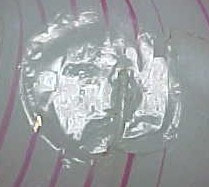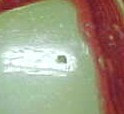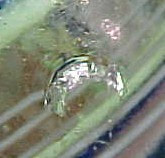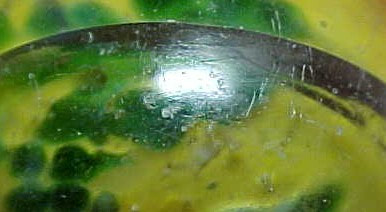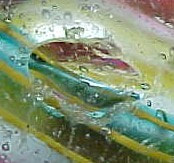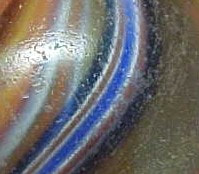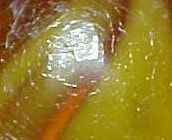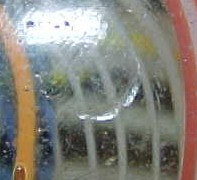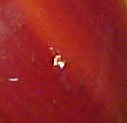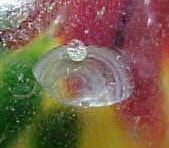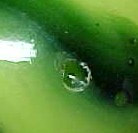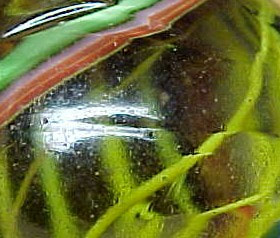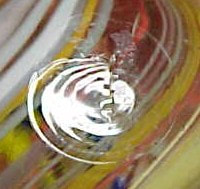marbles 101 & F.A.Q.
1. A BRIEF INTRODUCTION TO MARBLES
Better evidence, that provided by historic documentation, definitely places more secure origins for marbles in the late 15th to early 16th centuries, as European paintings and manuscripts from that period do illustrate or mention games involving these little orbs. By the 17th century the game had become common and had even spread to America. The Dutch seem to have been responsible for much of the diffusion of the game's popularity.
The first marbles were produced from stone, primarily limestone, though other materials such as agate and alabaster. The manufacture of earthenware (i.e. clay) marbles became popular in the 1800s, and by 1850 the first true glass marbles were produced in the Thuringen region of Germany. Marbles were made by hand until American inventors of the early 20th century perfected the use of machinery to create marbles.
Marbles were also available in a wide range of sizes (they are measured by their diameter). Some are as small as 13/32" (about the size of a pea) while others exceed (very rarely) two or more inches in diameter. The size of a marble depended on the type of game for which it was used; certainly, no one would ever have attempted to "knuckle down" with a 2 1/2" sphere! In general terms, collectors call any marble with a diameter of 1/2" or less a "peewee," while a "shooter" is most often defined as being at least 3/4".
Throughout the years, marble players have applied particular names to marbles. These names often have venerable origins and originally referred to the material of the marble, though later was used to refer to glass marbles, which often tried to mimic the appearance of their predecessors. For instance, "allies" first denoted alabaster marbles, while "aggies" referred to agates. These terms were later adopted by not only children playing with glass marbles, but also some of the companies manufacturing the marbles. Some of these companies also labeled their marbles to reflect the type of stone they were hoping to imitate with glass: "Carnelian" and "Onyx" are two such terms.
Besides a couple hundred individual craftsmen (and craftswomen) currently making glass and ceramic marbles for collectors, there are few companies that actually still make marbles for use in games. Most of these companies use modern machinery to mass produce marbles, though some are still being hand made in China. There are factories in China, Japan and Pakistan making marbles, while a Mexican corporation, Vacor de Mexico, is presently the most prolific manufacturer, exporting their colorful marbles all over the world.
In America, all but one of the marble companies that were so prominent in the middle part of the 20th century have closed their doors. The last company is Marble King, Inc. Based in West Virginia along the Ohio River (where the vast majority of American marble companies were originally established), Marble King continues to make marbles for children and large quantities of industrial use marbles.
- How long have marbles and marble games been around?
Better evidence, that provided by historic documentation, definitely places more secure origins for marbles in the late 15th to early 16th centuries, as European paintings and manuscripts from that period do illustrate or mention games involving these little orbs. By the 17th century the game had become common and had even spread to America. The Dutch seem to have been responsible for much of the diffusion of the game's popularity.
The first marbles were produced from stone, primarily limestone, though other materials such as agate and alabaster. The manufacture of earthenware (i.e. clay) marbles became popular in the 1800s, and by 1850 the first true glass marbles were produced in the Thuringen region of Germany. Marbles were made by hand until American inventors of the early 20th century perfected the use of machinery to create marbles.
- What types of marbles are there?
Marbles were also available in a wide range of sizes (they are measured by their diameter). Some are as small as 13/32" (about the size of a pea) while others exceed (very rarely) two or more inches in diameter. The size of a marble depended on the type of game for which it was used; certainly, no one would ever have attempted to "knuckle down" with a 2 1/2" sphere! In general terms, collectors call any marble with a diameter of 1/2" or less a "peewee," while a "shooter" is most often defined as being at least 3/4".
Throughout the years, marble players have applied particular names to marbles. These names often have venerable origins and originally referred to the material of the marble, though later was used to refer to glass marbles, which often tried to mimic the appearance of their predecessors. For instance, "allies" first denoted alabaster marbles, while "aggies" referred to agates. These terms were later adopted by not only children playing with glass marbles, but also some of the companies manufacturing the marbles. Some of these companies also labeled their marbles to reflect the type of stone they were hoping to imitate with glass: "Carnelian" and "Onyx" are two such terms.
- Who made marbles, and who still makes them?
Besides a couple hundred individual craftsmen (and craftswomen) currently making glass and ceramic marbles for collectors, there are few companies that actually still make marbles for use in games. Most of these companies use modern machinery to mass produce marbles, though some are still being hand made in China. There are factories in China, Japan and Pakistan making marbles, while a Mexican corporation, Vacor de Mexico, is presently the most prolific manufacturer, exporting their colorful marbles all over the world.
In America, all but one of the marble companies that were so prominent in the middle part of the 20th century have closed their doors. The last company is Marble King, Inc. Based in West Virginia along the Ohio River (where the vast majority of American marble companies were originally established), Marble King continues to make marbles for children and large quantities of industrial use marbles.
2. WHAT ARE MY MARBLES WORTH AND HOW IS VALUE DETERMINED?
Since marbles are now so widely available, as regards the venue from which they can be purchased, do your homework. Find a reputable dealer, follow eBay auctions for a type in which you're interested. Look up the values in price guides, and check out web sites to see if the marble is offered there. Attend shows and do comparative shopping. I have literally purchased certain marbles at a show, only to move to the very next table and find the same ones for a fraction of the cost! Don't rush in to a purchase unless the marble is just that rare---there will be another one available and a little patience can save you some major money.
Obviously, a person can earn a profit for selling marbles. Otherwise, I would not be able to pay for this web site! However, this can be difficult and you have to have your finger on the pulse of the market, so to speak. When a bargain is obvious, snap up the marble if you don't personally want it for display but know you can turn it over for a few dollars. But also be careful...there are some glaring examples of people who lost big time through speculating. For instance, Akro Agate "Popeye Patches" and Marble King "Blended Spidermen" used to bring up to $100 each. They were that rare. But then they started appearing at shows in greater numbers and some thinking they could make a killing bought as many as they could find for, say, $20 each. Those who sold quickly probably came out just fine. But those who held onto them were in for a nasty surprise: soon it was discovered that the marbles were being unearthed in huge numbers at dump sites. Today, one is lucky to get a buck for the blue and yellow Popeye Patch, while the Blended Spiderman, by no means as available, demands a price of around $10.
Perhaps a better way of viewing your collection as able to be sold for a profit is long term. Marble prices are always fluctuating up and down but like stocks and bonds, the prices have a general upward trend. The collectible world took a huge in 2008 and is still recovering. Is the potential for a long term investment is more secure than short term? No one knows what the future holds. Most collectors are getting up in years, and not many younger collectors are taking there place as they pass.
A final word of advice: if you try to sell off your entire collection you're going to discover you will make less overall than if you sold the marbles individually. This is particularly true if the buyer is a dealer. Remember that a dealer has to make some money in the resale, so don't expect to get "book" prices for your marbles. The general rule in this case, which holds true for just about any type of collectible, is that a dealer will offer you about half of what he expects to eventually make.
4. HOW IS THE CONDITION OF MARBLES DETERMINED?
So how are marbles graded, then? I know of several methods, mostly macroscopic. Some people hold the marble anywhere from six inches to a foot or more from the naked eye and judge based on their ability to detect damage from this distance. This method is very subjective and is dependent upon that person's eyesight: obviously those with 20/20 vision are going to give a more accurate assessment than those who are farsighted! Another system uses this "eyeballing" technique, with the addition of feeling the marble's surface with the fingernail to discover damage that is otherwise undetectable. Again, while better than the first method, it is weakened by subjectivity.
My favorite grading method is microscopic, though this too has inherent flaws. For instance, what power of magnification is used? I know of people who use 3X, 5X, 10X, and even 20X. I personally like 20X, because I want to be absolutely sure that if I say a marble is Mint, then indeed it is. No matter what method of grading is used, all collectors should be equipped with a jeweler's loupe with 10X magnification. These are handy not only for grading, but also for detecting repaired marbles.
HOW TO GRADE A MARBLE
Let's look at each range of condition now. Though there are various definitions of what constitutes a certain grade, I'll use mine, since few would disagree with my approach.
The second system is numerically based and often controversial, since there is no set standard for most of this precise grading. The following is used for Numeric Grading:
SURFACE DAMAGE
- How do I figure out how much a marble is worth?
Since marbles are now so widely available, as regards the venue from which they can be purchased, do your homework. Find a reputable dealer, follow eBay auctions for a type in which you're interested. Look up the values in price guides, and check out web sites to see if the marble is offered there. Attend shows and do comparative shopping. I have literally purchased certain marbles at a show, only to move to the very next table and find the same ones for a fraction of the cost! Don't rush in to a purchase unless the marble is just that rare---there will be another one available and a little patience can save you some major money.
- Are marbles a good investment?
Obviously, a person can earn a profit for selling marbles. Otherwise, I would not be able to pay for this web site! However, this can be difficult and you have to have your finger on the pulse of the market, so to speak. When a bargain is obvious, snap up the marble if you don't personally want it for display but know you can turn it over for a few dollars. But also be careful...there are some glaring examples of people who lost big time through speculating. For instance, Akro Agate "Popeye Patches" and Marble King "Blended Spidermen" used to bring up to $100 each. They were that rare. But then they started appearing at shows in greater numbers and some thinking they could make a killing bought as many as they could find for, say, $20 each. Those who sold quickly probably came out just fine. But those who held onto them were in for a nasty surprise: soon it was discovered that the marbles were being unearthed in huge numbers at dump sites. Today, one is lucky to get a buck for the blue and yellow Popeye Patch, while the Blended Spiderman, by no means as available, demands a price of around $10.
Perhaps a better way of viewing your collection as able to be sold for a profit is long term. Marble prices are always fluctuating up and down but like stocks and bonds, the prices have a general upward trend. The collectible world took a huge in 2008 and is still recovering. Is the potential for a long term investment is more secure than short term? No one knows what the future holds. Most collectors are getting up in years, and not many younger collectors are taking there place as they pass.
- Can I trust the price guides?
A final word of advice: if you try to sell off your entire collection you're going to discover you will make less overall than if you sold the marbles individually. This is particularly true if the buyer is a dealer. Remember that a dealer has to make some money in the resale, so don't expect to get "book" prices for your marbles. The general rule in this case, which holds true for just about any type of collectible, is that a dealer will offer you about half of what he expects to eventually make.
4. HOW IS THE CONDITION OF MARBLES DETERMINED?
- How do I grade the condition of a marble?
So how are marbles graded, then? I know of several methods, mostly macroscopic. Some people hold the marble anywhere from six inches to a foot or more from the naked eye and judge based on their ability to detect damage from this distance. This method is very subjective and is dependent upon that person's eyesight: obviously those with 20/20 vision are going to give a more accurate assessment than those who are farsighted! Another system uses this "eyeballing" technique, with the addition of feeling the marble's surface with the fingernail to discover damage that is otherwise undetectable. Again, while better than the first method, it is weakened by subjectivity.
My favorite grading method is microscopic, though this too has inherent flaws. For instance, what power of magnification is used? I know of people who use 3X, 5X, 10X, and even 20X. I personally like 20X, because I want to be absolutely sure that if I say a marble is Mint, then indeed it is. No matter what method of grading is used, all collectors should be equipped with a jeweler's loupe with 10X magnification. These are handy not only for grading, but also for detecting repaired marbles.
HOW TO GRADE A MARBLE
Let's look at each range of condition now. Though there are various definitions of what constitutes a certain grade, I'll use mine, since few would disagree with my approach.
- Mint is the easiest, since such a marble has no visible damage. Under magnification, if I can still detect no damage whatsoever, the marble is Mint (+). If there is just a hint of wear, or a tiny rub spot or abrasion invisible to the naked eye, then it is Mint. If, under magnification, I can find a pinprick, tiny subsurface moon or reflection, or a sparkle, but no damage that can be felt with the fingernail, I rate it Mint (-).
- Near Mint range is pretty straight forward, too. Such a marble will have visible damage or at least enough microscopic damage for me to not want to classify it as Mint (-). Near Mint (+) marbles may have a small flake or two, or a couple moons or some such defect, but otherwise be free of wear and able to be viewed mint from at least one angle. Near Mint marbles will have more numerous or larger flakes, moons, or other minor damage, but still have at least one side that can be seen as mint. Near Mint (-) specimens, on the other hand, will have multiple flakes, moons, scratches, abrasions, and so forth, but no exterior damage that is very deep or large. Such a marble may have overall damage but generally less than a quarter of the overall surface will be affected.
- Good range, now things get a bit more difficult. I am often at wit's end whether or not to classify some marbles as Good (+) and Near Mint (-), and indeed in my own opinion this is perhaps the most subjective division in the grading system. Good (+) marbles will have a substantial amount of damage, a bit more than marbles that can squeak through into the Near Mint range; the damage can be larger and deeper. Good marbles might have such damage covering up to 50% of the overall surface, and may also include damage so deep that polishing the marble could not remove it. Good (-) marbles are at the very fringe of what is worth keeping and what you want to toss. Such examples may have almost no areas of glass unaffected by damage and wear. On transparent marbles, the wear, haze, and frostiness on the remaining surface may be so bad you cannot see what is inside the marble.
- Collectible is a grading term that makes me cringe. First, are not marbles in better condition also collectible? Second, since this grade covers the remaining range of condition, would you truly consider a "2.5" condition marble worth keeping? The difference here lies in the rarity of the marble; an Akro Corkscrew, for instance, would be worthless in 5.0 condition, but a two inch black-based Clambroth in the same condition would still maintain some level of collectibility. I now prefer to use the term "Poor" instead of "Collectible." Whichever your opinion, the fact is that a Poor/Collectible marble will have deep damage, and a lot of it.
The second system is numerically based and often controversial, since there is no set standard for most of this precise grading. The following is used for Numeric Grading:
- 10.0 (Pristine): This describes a perfect marble, with a "wet," clean surface even under magnification. All contemporary marbles should have this grade, though very few antique or vintage marbles will ever be graded as such.
- 9.7-9.9 (Mint +): There is no damage present, even under magnification, though the marble is not quite a perfect "10."
- 9.3-9.6 (Mint): To the unaided eye, this describes a marble with no damage, though under magnification there may be one or two pinpricks, a hint of wear, or an abrasion or rub spot. Marbles in this range may have a small "as-made" such as a pinprick-sized blow-out pit or a touch spot.
- 9.0-9.2 (Mint -): Mint (-) marbles will have no missing glass, with the exception perhaps of some microscopic pinpricks. There may be minor wear, a sparkle or two, or a tiny subsurface reflection or moon.
- 8.7-8.9 (Near Mint +): These marbles are almost in the Mint range, but may have a tiny flake or moon, or two, as well as a few sparkles, subsurface reflections/moons, minor "as-mades," and/or minor wear. Near Mint (+) marbles will have at least one angle from which they view Mint.
- 8.3-8.6 (Near Mint): This range describes marbles that have the same sort of description seen on Near Mint (+) marbles, only to a higher degree. One side should still be viewed Mint.
- 8.0-8.2 (Near Mint -): These marbles will have the same sort of damage seen on specimens in the upper Near Mint ranges but only more so. No side will be viewable as Mint, but the damage will not be deep or cover more than one quarter of the marble's surface, with the exception of overall wear.
- 7.7-7.9 (Good +): The difference between marbles in this range and those that are Near Mint (-) is highly subjective, though such marbles will have over one quarter of the surface covered with damage, but not more than 50%. A Good (+) marble should be able to be reconditioned (polished) without too much glass required to be removed.
- 7.3-7.6 (Good): Good marbles will have substantial damage, some of it deep enough so that polishing may not remove it all. Roughly half of the surface will have damage, and wear is generally heavy.
- 7.0-7.2 (Good -): More than 50% of the surface has damage, including substantial chips, and you would probably not want to collect such a marble unless it were extremely rare or if you planned on having it reconditioned. Polishing will probably not remove all the damage without substantially reducing the size of the marble.
- 6.7-6.9 (Poor +): Poor (+) marbles are so beat up that there has to be a really good reason it would still be desirable. You would be taking a risk to try to have such a marble polished.
- 6.3-6.6 (Poor): Marbles in Poor condition have so much damage you can barely tell what type it is. These are beyond repair.
- 6.0-6.2 (Poor -): A marble in this condition is so beat up that there would be no reason to want to own it, unless it happens to be a unique example. 5.9 and under (Non-Collectible): Throw it away!
- What types of damage can a marble have?
SURFACE DAMAGE
- Chips are left when pieces of material are broken away from the marble. They tend to be large and deep, and are often angular.
- Flakes are generally more shallow and, as the name suggests, are bits of material that have been flaked away. They can be large but for the most part are small.
- Pinpricks are what they sound like: pin-point sized pieces of missing glass. They usually cannot be easily seen or felt, but are evident under magnification. (Also referred to as Flea Bites, Chiggers, etc. by collectors)
- Surface moons are crescent-shaped flakes. They often occur as a result of impact against a hard object.
- Scratches are pretty much self-explanatory. They are usually shallow and may be hard to see, though they can be felt with a fingernail.
- Surface fractures are hairline cracks in a marble. Some are caused by annealing, or the cooling of the marble during manufacture, though some are caused by impact or hot and cold temperatures.
- Pits are generally small, round areas on the surface of a marble. Often caused during manufacture, they are usually the result of trapped pockets of air just under the surface being exposed by glass breaking away.
- Wear is a condition on a marble that does not really constitute missing glass, but a general dulling over the surface due to use. Other types of wear may be the result of aging and chemical weathering: hazing is an appearance of glass where the surface is dulled, making it difficult to see inside the marble; frostiness is a more advanced form of hazing where the marble's surface is so weathered that one cannot see into the interior (if transparent); patination is a condition in which the surface of the glass is weathered and has taken on an iridescent appearance.
- Crazing is a condition where the surface of a marble is covered with fine fractures with an almost spiderweb-like appearance. Sometimes caused by annealing, it can also result from age and weathering, and is particularly common among dug marbles.
- Abrasions and rub-spots are minor types of damage that aren't really severe enough to consider scratches. These usually occur during manufacturing when thousands of marbles are grouped into single containers.
- Subsurface moons are similar to surface moons in appearance, but are completely inside the glass and involve no missing material.
- Sparkles are pinprick-sized reflections beneath the surface. They often are only seen when the marble is held at a certain angle, and they are made visible by the fact that they reflect light.
- Reflections are like sparkles, but are larger in size. The term is often interchangeable with subsurface moons.
- Bruises are round areas on the marble resulting from impact. The glass is literally bruised and takes on a discoloration. These begin at the surface but are mostly beneath it, and involve no missing glass.
- Subsurface fractures are completely under the surface. Again, they may have formed during the cooling process, but also can occur after manufacture.
- Annealing fractures are been discussed above. They are caused when the glass improperly cools during the final stage of manufacture.
- Blow-outs are naturally occurring pits. Trapped air bubbles just under the surface burst during cooling, leaving usually small round pits.
- Cold Roll lines are linear depressions in the surface of marbles that are hand made. They may also occur in machine made marbles that were not properly rounded as they descended the machinery's chutes.
- Seediness is a condition in glass where microscopic air bubbles are trapped at the surface.
- Craters often occur in handmade marbles where, apparently, the still hot glass is impacted by something. They are usually small, round, shallow depressions with concentric rings.
TYPES OF MARBLE DAMAGE GALLERY
(Hover your mouse or lightly touch the image to see the type of marble. Click to view the full size image)
(Hover your mouse or lightly touch the image to see the type of marble. Click to view the full size image)
I UNDERSTAND ALL OF THE INFORMATION ABOVE, BUT I'M STILL CONFUSED!
Such names adopted by collectors stuck in many cases and today are widely used to identify specific marbles. Unfortunately, as the popularity of the hobby gains momentum more and more people are applying names of their own choosing to certain previously unnamed marbles, causing the "old time" collectors to often ring their hands in frustration. Now, they protest, we have to contend with the Akro Agate Superman, the Christensen Agate Superman, and even the Vacor de Mexico Superman! Other recent names are more imaginative, and while many are not readily accepted, most collectors have noted that previously unnamed marbles that now have accepted names, like the Peltier "Superboy" for instance, skyrocket in price once the name sticks. This can be good or bad, depending on whether you're selling or buying the marble in question! It is almost impossible to keep up with all the new names assigned by collectors.
As you progress through this hobby, you'll learn that machine made marbles from different companies have often subtle differences in glass color, seam configuration, patterning, etc. Soon, it will be obvious to you when you hold a marble in hand whether or not it is vintage. In general terms, and applying primarily to opaque colors in machine made marbles, older glass is brighter, more vibrant, and more opaque. Newer marbles often have a dull look to the colors, and the opacity often borders on translucency.
Explaining these differences in text is very difficult, and really the best method is going to be through direct experience...by handling as many marbles as you can. Therefore, you're going to have to attend marble shows! Even so, be warned: experienced collectors are not immune to making errors. I just received a collection on consignment from a person who has been collecting ten years, and mixed in with the Christensen Agate marbles (which date to the late 1920s) were several Mexican marbles with similar coloring and designs, but made only recently. There were also a couple fakes: modern torchmade marbles intentionally created by a glass artist to look like these older examples. So don't be frustrated by being ripped off or unintentionally fooled. Think of it as a lesson, albeit perhaps an expensive one. When it comes to accidentally purchasing modern marbles that you think are old is not a matter of "if," it's a matter of "when."
Even though I do tout experience as the best tool for protecting yourself against buying newer marbles, thinking them old and valuable, some books and web sites do offer guides on avoiding modern machine made or contemporary hand made marbles (or original packaging, for that matter) misrepresented as genuine. This website is a good place to begin!
- What is with all the different marble names?
Such names adopted by collectors stuck in many cases and today are widely used to identify specific marbles. Unfortunately, as the popularity of the hobby gains momentum more and more people are applying names of their own choosing to certain previously unnamed marbles, causing the "old time" collectors to often ring their hands in frustration. Now, they protest, we have to contend with the Akro Agate Superman, the Christensen Agate Superman, and even the Vacor de Mexico Superman! Other recent names are more imaginative, and while many are not readily accepted, most collectors have noted that previously unnamed marbles that now have accepted names, like the Peltier "Superboy" for instance, skyrocket in price once the name sticks. This can be good or bad, depending on whether you're selling or buying the marble in question! It is almost impossible to keep up with all the new names assigned by collectors.
- How can I tell old from new?
As you progress through this hobby, you'll learn that machine made marbles from different companies have often subtle differences in glass color, seam configuration, patterning, etc. Soon, it will be obvious to you when you hold a marble in hand whether or not it is vintage. In general terms, and applying primarily to opaque colors in machine made marbles, older glass is brighter, more vibrant, and more opaque. Newer marbles often have a dull look to the colors, and the opacity often borders on translucency.
Explaining these differences in text is very difficult, and really the best method is going to be through direct experience...by handling as many marbles as you can. Therefore, you're going to have to attend marble shows! Even so, be warned: experienced collectors are not immune to making errors. I just received a collection on consignment from a person who has been collecting ten years, and mixed in with the Christensen Agate marbles (which date to the late 1920s) were several Mexican marbles with similar coloring and designs, but made only recently. There were also a couple fakes: modern torchmade marbles intentionally created by a glass artist to look like these older examples. So don't be frustrated by being ripped off or unintentionally fooled. Think of it as a lesson, albeit perhaps an expensive one. When it comes to accidentally purchasing modern marbles that you think are old is not a matter of "if," it's a matter of "when."
Even though I do tout experience as the best tool for protecting yourself against buying newer marbles, thinking them old and valuable, some books and web sites do offer guides on avoiding modern machine made or contemporary hand made marbles (or original packaging, for that matter) misrepresented as genuine. This website is a good place to begin!
- Try as I might, I still can't identify my marble! What gives?


